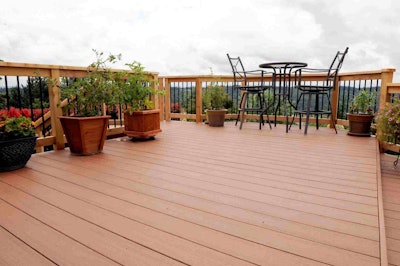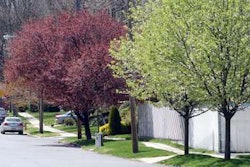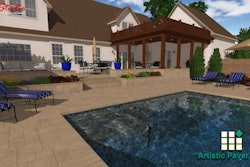 Photo Courtesy of Rick’s Fencing
Photo Courtesy of Rick’s FencingResurface rather than rebuild
Every wood deck has a limited lifetime; it’s just the nature of the material. However, if you’re considering rebuilding a client’s deck, you may find there isn’t a need to tear it down completely. When the substructure of a wood deck is still in good shape, simply resurfacing the structure can give you the results you want at a fraction of the cost.
What is deck resurfacing?
When you resurface a wood deck, you remove the current deck boards and have the substructure inspected and prepared. You then add new deck boards to the substructure, giving you essentially a new deck in a fraction of the time. Many don’t think twice about resurfacing a deck with wood boards, but you may find PVC to be a superior, cost-efficient alternative.
What is PVC decking?
Polyvinyl chloride, or PVC, is a thermoplastic polymer that’s often used in construction. Many contractors prefer PVC over other building materials because of its usefulness in multiple applications and because of its high hardness and insulation properties. Because of its low cost and chemical and biological resistance, it’s common to see PVC used for pipes or on the sides of houses as vinyl siding.
Since cellular PVC is flexible, manufacturers can make deck boards from it that mimic the appearance of wood. PVC’s tough surface prevents the buildup of dirt, so it helps a deck stay cleaner. Because PCV is waterproof and resists fading, you don’t have to stain it or use a protective coating.
Other benefits of PVC include:
- Split resistance
- Stain resistance
- Scratch resistance
- Resistance to mold and mildew
- Durability
- Water resistance
- Imperviousness to insects
Why resurface a wood deck with cellular PVC decking?
When you look at the different materials available for deck boards, you’ll find that those made of cellular PVC are more expensive per square foot than wood. PVC’s durability, however, enables the resurfacing project to pay for itself in about five years. Many PVC deck manufacturers also offer warranties of up to 20 years on their products, so you can have peace of mind if you ever encounter a problem.
The following are some other advantages cellular PVC offers over wood:
Low maintenance and high durability. Wood is prone to peeling, fading, warping, flaking, splitting, water damage, insect damage and rot. PVC, on the other hand, is not. When you own a wood deck, you have to perform regular maintenance to prolong its life. With PVC, you can simply hose it down with water to keep it looking new.
Safety. Unlike wood, PVC is flame retardant and doesn’t support combustion, so homeowners can fire up the grill without any worries. Because PVC resists mold and mildew growth and has a slip-resistant surface, you don’t have to worry about slipping on the deck boards when they get wet or if your area experiences prolonged rainy periods.
Sustainability. Unless you use reclaimed wood to resurface a deck, the trees cut down to build the decking materials may contribute to deforestation if sustainable harvesting practices weren’t used to harvest the lumber. On the other hand, PVC is an energy-efficient material to produce; it’s recyclable, made from recycled products; and it includes natural fillers like rice husks or flax seeds. Since a PVC deck is virtually maintenance-free, you don’t have to use harmful wood preservatives or toxic finishing treatments to keep it looking great.
Why build a new deck when you can use the framework already in place? Use the money you save from choosing to resurface your client’s deck by investing it in worry-free PVC deck boards that will last through the next generation.
EDITOR’S NOTE: This guest post is brought to you by Rick’s Custom Fencing & Decking. Rick’s Fencing provides materials, design and installation of wood decks and fences throughout Oregon & Washington.









